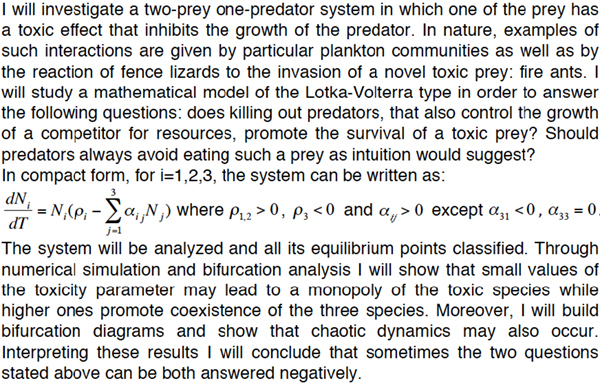MIMS MBSセミナー (旧称:GCOE MEEセミナー)
- ホーム
- セミナー・シンポジウム
- MBSセミナー
MIMS Mathematical Biology Seminar (MBS Seminar)(旧称:GCOE MEEセミナー)
(Organizers: J.Y. Wakano and R. Okajima)
Everyone is welcome to attend the MBS seminar.
- MBS seminar is partly supported by, "Meiji institute for Advanced Study of Mathematical Science (MIMS)"
Access to Nakano Campus:
- http://www.meiji.ac.jp/koho/campus_guide/nakano/access.html (in Japanese)
- http://www.meiji.ac.jp/cip/english/about/campus/na_campus.html (in English)
* MBS Seminar (No. 047)
Date: Oct. 11. 2016 15:00~16:00
Location: Meiji Univ. Nakano campus, Room 602
Campus map: in Japanese in EnglishWilliam Gilpin
(Department of Applied Physics, Stanford University)Vivek N. Prakash
(Department of Bioengineering, Stanford University)Manu Prakash
(Department of Bioengineering, Stanford University)
Vortex arrays and ciliary tangles underlie the feeding-swimming tradeoff in starfish larvaeAbstract:
Many marine invertebrates have larval stages covered in linear arrays of beating cilia, which propel the animal while simultaneously entraining planktonic prey. These bands are strongly conserved across taxa spanning four major superphyla, and they are responsible for the unusual morphologies of many invertebrates. However, few studies have investigated their underlying hydrodynamics. Here, we study the ciliary bands of starfish larvae, and discover a beautiful pattern of slowly-evolving vortices that surrounds the swimming animals. Closer inspection of the bands reveals unusual ciliary “tangles” analogous to topological defects that break-up and re-form as the animal adjusts its swimming stroke. Quantitative experiments and modeling demonstrate that these vortices create a physical tradeoff between feeding and swimming in heterogenous environments, which manifests as distinct flow patterns or "eigenstrokes" representing each behavior---potentially implicating neuronal control of cilia. This quantitative interplay between larval form and hydrodynamic function generalizes to other invertebrates, and illustrates the potential effects of active boundary conditions in other biological and synthetic systems.
* MBS Seminar (No. 046) 【Poster】
Date: Nov. 12. 2014 16:00~17:00
Location: Meiji Univ. Nakano campus, Room 601
Campus map: in Japanese in EnglishProfessor Sergey Gavrilets
(University of Tennessee)Evolution of social instincts in within- and between-group conflicts
Abstract:
I model the effects of within-group inequality on the evolution of social instincts, i.e. genetically-based propensities and biases that affect the behavior of individuals in social interactions. First, I consider competitive within-group interactions. I identify a novel mechanism for the evolutionary emergence of the "egalitarian syndrome" and leveling coalitions in which one helps the weak against the strong bully. Second, I study a collective action problem in between-group conflicts and show how bullies can dialectically become "altruists". The mechanisms I describe do not require genetic relatedness, reciprocity, reputation, or punishment.
* MBS Seminar (No. 045) 【Poster】
Date: Nov. 19. 2013 14:30~16:00
Location: Meiji Univ. Nakano campus, Room 822
Campus map: in Japanese in EnglishMayuko Nakamaru
(Tokyo Institute of Technology)Memory and cumulative culture
Abstract:
Evolution of learning is one of interesting research topics from the viewpoint of evolution and social sciences. The cognitive abilities are required to learn cultural traits. Take memory for instance. After we learn new cultural traits, we have to consolidate them. After keeping them in storage, memories should be retrieved. Otherwise, we can neither utilize the traits to improve our fitness or social lives, nor develop our cultural traits. However, many theoretical studies implicitly assume that humans are equipped with cognitive abilities to learn and utilize cultural traits perfectly because of simplifying the assumptions for mathematical models. We have to pay costs for having and utilizing cognitive abilities from the viewpoint of evolution. We have not known which cost is higher, memory or learning. If the memory cost is higher than the learning cost, it may be more fficient to forget the learned traits and learn them repeatedly than to keep them in storage according to the cost-benefit analysis. There may be some possible hypotheses to explain why human have the high cognitive ability of memory. I propose the cumulative cultural hypothesis: to develop cultural traits, it is necessary for us to have the high ability of memory even though it is costly. In this talk, to verify my hypothesis, I make a simple mathematical model of learning and memory, which assumes consolidation, storage and retrieval. Then we investigate how memory costs and a learning cost influence the evolution of cumulative culture. Then we discuss the Tasmanian effect based on my research outcomes.
* MBS Seminar (No. 044) 【Poster】
Date: Nov. 12. 2013 14:30~16:30
Location: Meiji Univ. Nakano campus, Room 822
Campus map: in Japanese in EnglishLaurel Fogarty
(Stanford University)Age structured cultural evolution
Abstract:
Data published by Hewlett et al (2011) showed that the age structure of cultural learning differs between modern hunter-gatherer groups and their agriculturalist neighbors. We used Leslie matrix models to investigate the implications of these differences for cultural evolution in each group, and more generally in groups with different age-structured learning regimes. These models show how traits affecting survival, fertility, or both can influence the birth rate, age structure, and asymptotic growth rate of a population. We show that the strong spread of some traits can lead to a demographic transition, similar to that experienced in Europe in the late 19th and early 20th centuries, without ecological or economic optimizing models. The spread of a cultural trait that increases fertility, but not survival, can cause demographic change similar to the `Neolithic demographic transition'; a period of increased population growth that is thought to have accompanied the transition from hunter-gatherer to agricultural lifestyles. Finally, extensions to the above model allowing a more natural division of age classes could make the models more useful to anthropologists studying agestructured cultural transmission. We plan to investigate ways in which this approach can be improved and optimized for use with field data.
* MBS Seminar (No. 043) 【Poster】
Date: Nov. 5. 2013 14:30~16:00
Location: Meiji Univ. Nakano campus, Room 822
Campus map: in Japanese in EnglishRyo Yamaguchi
(Kyushu University)First Passage Time to Allopatric Speciation
Abstract:
Allopatric speciation is a mechanism that can lead to the creation of novel species; it is caused by the accumulation of genetic differences between populations while they are geographically isolated. Here, we studied a simple stochastic model for the time until speciation caused by geographic isolation in fragmented populations that experience recurrent but infrequent migration between sub-populations. We assumed that mating incompatibility is controlled by a number of loci that behave as neutral characters in the accumulation of novel mutations within each population. Genetic distance between populations was defined as the number of incompatibility-controlling loci that differ between them. Genetic distance increases through the separate accumulation of mutations in different populations, but drops after a successful migration event followed by genetic mixing between migrants and residents. We calculated the time to allopatric speciation, which occurs when the genetic distance exceeds a specified threshold. If the number of invasive individuals relative to the resident population is not very large, diffusion approximation provides an accurate prediction. There is an intermediate optimal rate of migration that maximises the rate of species creation by recurrent invasion and diversification. We also examined cases that involved more than two populations.
* MBS Seminar (No. 042) 【Poster】
Date: Jun 5. 2013 13:15~14:30
Location: Meiji Univ. Nakano campus, Room 601
Campus map: in Japanese in EnglishTommaso Scotti
(Meiji University)Does toxicity promote coexistence?
Abstract:

* MBS Seminar (No. 041) 【Poster】
Date: May 29. 2013 13:00~14:30
Location: Meiji Univ. Nakano campus, Room 305
Campus map: in Japanese in EnglishJoe Yuichiro Wakano
(Meiji University)Evolutionary branching in a finite population: Deterministic branching versus stochastic branching
Abstract:
Adaptive dynamics formalism demonstrates that, in a constant environment, a continuous trait may first converge to a singular point followed by spontaneous transition from a unimodal trait distribution into a bimodal one, which is called "evolutionary branching". Most previous analyses of evolutionary branching have been conducted in an infinitely large population. Here, we study the effect of stochasticity caused by the finiteness of the population size on evolutionary branching. By analyzing the dynamics of trait variance, we obtain the condition for evolutionary branching as the one under which trait variance explodes. Genetic drift reduces the trait variance and causes stochastic fluctuation. In a very small population, evolutionary branching does not occur. In larger populations, evolutionary branching may occur, but it occurs in two different manners: in deterministic branching, branching occurs quickly when the population reaches the singular point, whilst in stochastic branching, the population stays at singularity for a period before branching out. The conditions for these cases and the mean branching-out times are calculated in terms of population size, mutational effects, and selection intensity, and are confirmed by direct computer simulations of the individual-based model.




